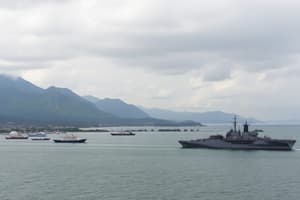Podcast
Questions and Answers
What was the primary purpose of the Neutrality Acts passed in the mid-1930s?
What was the primary purpose of the Neutrality Acts passed in the mid-1930s?
- To promote U.S. military expansion abroad
- To strengthen alliances with European countries
- To limit U.S. involvement in future wars (correct)
- To support belligerent nations in WWII
How did the Lend-Lease Act change U.S. foreign policy?
How did the Lend-Lease Act change U.S. foreign policy?
- It allowed U.S. to support allies while remaining neutral (correct)
- It prohibited trade with foreign nations
- It mandated military draft for American citizens
- It increased isolationism
What was Japan's main goal that led to the attack on Pearl Harbor?
What was Japan's main goal that led to the attack on Pearl Harbor?
- To establish peace with the United States
- To eliminate the U.S. Navy entirely
- To support Germany in WWII
- To conquer natural resources and lands (correct)
What was the significance of the Atlantic Charter established in 1941?
What was the significance of the Atlantic Charter established in 1941?
Which factor was NOT a reason for U.S. intervention in Japan's aggression?
Which factor was NOT a reason for U.S. intervention in Japan's aggression?
What event directly preceded the attack on Pearl Harbor, highlighting a failure in U.S. intelligence?
What event directly preceded the attack on Pearl Harbor, highlighting a failure in U.S. intelligence?
What was the outcome for the Japanese military structure during the time of the Pearl Harbor attack?
What was the outcome for the Japanese military structure during the time of the Pearl Harbor attack?
How many waves of attack were executed during the Pearl Harbor assault?
How many waves of attack were executed during the Pearl Harbor assault?
Flashcards
Neutrality Acts (1930s)
Neutrality Acts (1930s)
Passed in the 1930s to limit U.S. involvement in future wars, prohibiting the export of war supplies and loans to belligerent nations and restricting travel to these countries.
Lend-Lease Act (1940)
Lend-Lease Act (1940)
This act allowed the U.S. to lend or lease war supplies to any nation needed for the defense of the U.S., allowing the U.S. to help foreign allies while remaining 'neutral' in conflict.
Atlantic Charter (1941)
Atlantic Charter (1941)
A declaration signed by the U.S. and Great Britain outlining shared goals in opposing Hitler and his allies, emphasizing their shared opposition to fascism.
U.S. Embargo on Japan
U.S. Embargo on Japan
Signup and view all the flashcards
Pearl Harbor Attack
Pearl Harbor Attack
Signup and view all the flashcards
Military Attack
Military Attack
Signup and view all the flashcards
Fleet
Fleet
Signup and view all the flashcards
Japanese Message
Japanese Message
Signup and view all the flashcards
Study Notes
Pearl Harbor Attack
- Japan's goal was to destroy the US Pacific Fleet and conquer resources in the Pacific.
- The US placed an embargo on Japan, restricting trade of oil, scrap metal, and other resources.
- Japan felt the embargo threatened their access to natural resources needed for expansion.
- Japan planned a surprise attack on Pearl Harbor to cripple the US Pacific Fleet.
- The attack took place on December 7, 1941.
- Two waves of Japanese planes attacked the US fleet based at Pearl Harbor.
- Targets included battleships, aircraft carriers, airfields, and other military installations.
- The attack lasted approximately two hours.
- The attack aimed to cripple the US Pacific Fleet.
US Neutrality and Aggression
- The US attempted to stay out of international conflicts in the 1920s-1930s.
- The Neutrality Acts were passed to limit the US's involvement in future wars. These laws restricted the export of arms and other war supplies to warring countries.
- The Neutrality Acts were initially designed to prevent the US from getting involved in another European war, similar to WWI.
- The Lend-Lease Act of 1940 changed US policy, helping to support Britain and other allies against Germany.
- The US became heavily involved in World War II after the attack on Pearl Harbor.
Japanese Aggression
- Japan's military had considerable gains in Asia and the Pacific.
- Japan targeted resources held by other nations in the Pacific.
- Japan wanted to expand its military power and influence.
- The Japanese felt the US was blocking their efforts to expand their empire and wished to conquer resources and lands.
- Japan aimed to control vital parts of the pacific.
- Tojo was a significant military leader of Japan.
- Emperor Hirohito was the Emperor of Japan.
Planning of Pearl Harbor Attack
- The attack on Pearl Harbor was meticulously planned by Japan.
- The attack took a year in preparation.
- The plan was to cripple the US Pacific Fleet, and use air and sea power to take control of territories.
- The Japanese fleet traveled 4000 miles to launch the attack from near Hawaii.
- Approximately 200 miles north of Oahu, the carriers were positioned and launched their attack.
- Approximately 353 fighter planes, bombers and torpedoes were deployed.
- Submarines were also part of the initial plan.
Studying That Suits You
Use AI to generate personalized quizzes and flashcards to suit your learning preferences.
Related Documents
Description
This quiz covers the events surrounding the Pearl Harbor attack, highlighting Japan's strategic goals and the US's attempts at neutrality prior to World War II. Explore the implications of the Neutrality Acts and the significance of the December 7, 1941 attack that altered US foreign policy. Test your knowledge on this pivotal moment in history!




